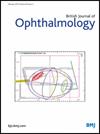青光眼的心理合并症:焦虑和抑郁的患病率和影响
IF 3.5
2区 医学
Q1 OPHTHALMOLOGY
引用次数: 0
摘要
目的利用标准化的心理测量工具评估青光眼患者中焦虑和抑郁的患病率,以确定与这些心理疾病相关的因素,并确定潜在的医疗保健差距。方法采用7项广泛性焦虑障碍(GAD-7)量表和患者健康问卷(PHQ-9)对249例青光眼患者进行评估。相关分析探讨了心理测量分数、一般身心健康功能、与视力相关的生活质量和生物社会因素之间的联系。结果:在参与者中,1.2%的人有焦虑诊断,11.2%的人有抑郁诊断,但筛查显示焦虑症和抑郁症的比例更高:42.2%和34.9%,表明明显的诊断不足(p<0.001)。PHQ-9评分与GAD-7评分呈正相关(p<0.001)。较高的PHQ-9分数与较差的心理和身体健康功能以及较低的视力相关生活质量(p<0.001)、女性、独居(p=0.02)、年龄较小和收入较低(p=0.01)有关。同样,较高的GAD-7评分与较差的心理健康功能和视力相关的生活质量(分别p<0.001)、女性(p=0.003)、较差的身体健康功能(p=0.03)和较低的收入(p=0.002)相关。结论青光眼患者焦虑和抑郁常被误诊,存在明显的医疗保健缺口。与普通人群相比,青光眼患者中这些疾病的患病率较高,这强调了常规心理测量筛查以加强检测和管理的必要性。弥合这一差距需要一种综合护理模式,将心理评估和支持纳入标准方案,实现针对年龄、性别、视力相关因素和社会经济因素的全面、以患者为中心的护理。如有合理要求,可提供资料。本文章由计算机程序翻译,如有差异,请以英文原文为准。
Psychological comorbidity in glaucoma: prevalence and impact of anxiety and depression
Purpose To assess the prevalence of anxiety and depression among individuals diagnosed with glaucoma, using standardised psychometric instruments, to define factors associated with these psychological diseases, and to identify a potential healthcare gap. Methods In this cross-sectional study, 249 patients with glaucoma were assessed using the 7-item Generalised Anxiety Disorder (GAD-7) scale and the Patient Health Questionnaire (PHQ-9). Correlation analyses explored links between psychometric scores, general mental and physical health functioning, vision-related quality of life and biosocial factors. Results Among participants, 1.2% had a prior anxiety diagnosis and 11.2% a depression diagnosis, yet screening revealed higher rates: 42.2% for anxiety and 34.9% for depression, indicating significant underdiagnosis (p<0.001, respectively). PHQ-9 and GAD-7 scores correlated strongly (p<0.001). Higher PHQ-9 scores were linked to poorer mental and physical health functioning as well as lower vision-related quality of life (p<0.001, respectively), female gender, living alone (p=0.02, respectively), younger age and lower income (p=0.01, respectively). Similarly, higher GAD-7 scores were associated with worse mental health functioning and vision-related quality of life (p<0.001, respectively), female gender (p=0.003), reduced physical health functioning (p=0.03) and lower income (p=0.002). Conclusion Anxiety and depression are frequently underdiagnosed in patients with glaucoma, highlighting a significant healthcare gap. The higher prevalence of these conditions in patients with glaucoma compared with the general population underscores the need for routine psychometric screening to enhance detection and management. Bridging this gap calls for an integrated care model that incorporates psychological evaluation and support into standard protocols, enabling comprehensive, patient-centred care tailored to age, gender, vision-related and socioeconomic factors. Data are available upon reasonable request.
求助全文
通过发布文献求助,成功后即可免费获取论文全文。
去求助
来源期刊
CiteScore
10.30
自引率
2.40%
发文量
213
审稿时长
3-6 weeks
期刊介绍:
The British Journal of Ophthalmology (BJO) is an international peer-reviewed journal for ophthalmologists and visual science specialists. BJO publishes clinical investigations, clinical observations, and clinically relevant laboratory investigations related to ophthalmology. It also provides major reviews and also publishes manuscripts covering regional issues in a global context.

 求助内容:
求助内容: 应助结果提醒方式:
应助结果提醒方式:


